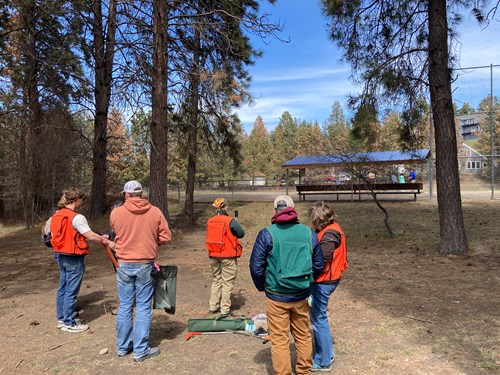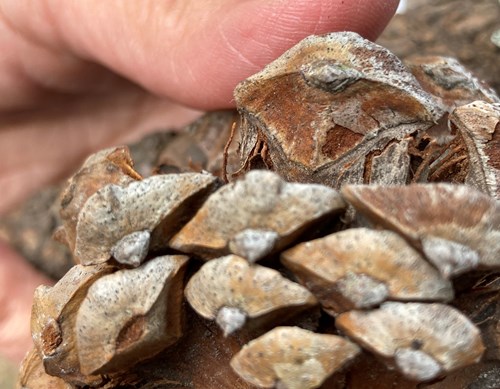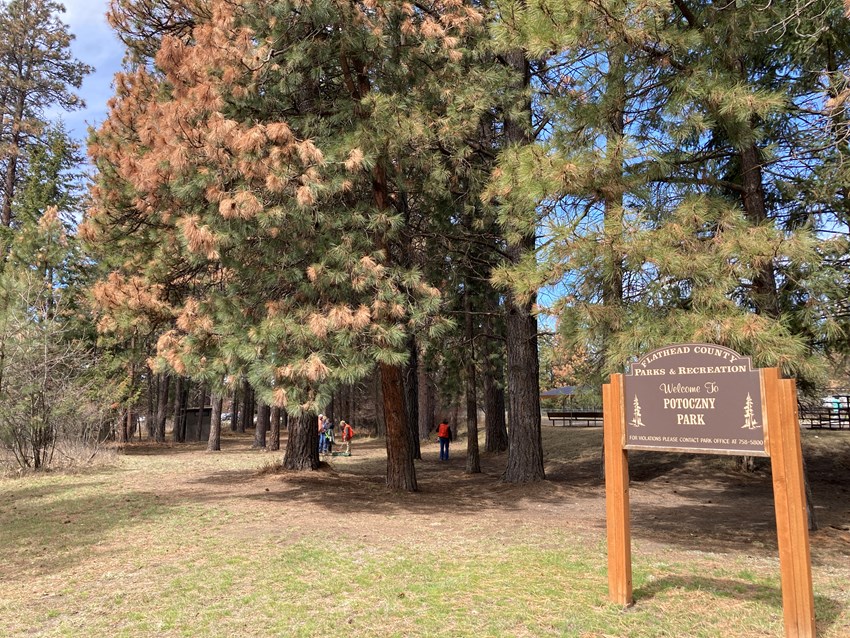Flathead Lake Bio Station and Flathead Valley Community College Launch Long-Term Educational Research Project to Assess Bigfork’s Storm-Damaged Ponderosa Pines
At first, the storm rolling over Bigfork on that summer afternoon in 2022 seemed like any other. Even as ominous thunderheads darkened the skies, and winds whipped the lake into white-capped waves that crashed against the docks and eastern shoreline of Flathead Lake.
This is big sky country, after all. A late-afternoon cloudburst or the steady grumble of thunder is rarely anything get too excited about—especially following an unseasonably wet spring that brought significant flooding to much of western Montana, as was the case in 2022. But the winds continued to howl and grow, at times exceeding 60 mile per hour, and as golf ball-sized hail began to batter the town, it became increasingly clear that this was no run-of-the-mill summer storm.
This was something else, and in the weeks that followed, people were left to wonder: “What did that storm do to our ponderosa pines?”
Nearly a year later, on a brisk spring morning in 2023, I parked my car at the Bigfork Post Office, where I had been invited to join FLBS research scientist and GIS specialist Diane Whited and a group of Flathead Valley Community College (FVCC) natural resources undergraduate research students and faculty.
Co-led by FVCC natural resources professor Christina Relyea and FVCC natural resources and surveying professor Tim Eichner, the group was embarking on a new a collaborative project between FLBS and FVCC. This philanthropically-dependent project is designed to integrate educational opportunities with meaningful monitoring and research that will track and analyze the fate of ponderosa pines in Bigfork.
The reason for the project’s existence is fairly plain to see. Only a few weeks after that 2022 hailstorm, the needles on ponderosa pines throughout Bigfork began to turn yellow. Since then, the problem has progressed. Whether only a branch or an entire tree, ponderosas with yellow and brown needles now seem to be everywhere from the Woods Bay area and into the Swan.

FVCC natural resources professor Christina Relyea and FLBS research scientist Diane Whited observe students and interns as they begin to record data on the storm-damaged ponderosa pines in Bigfork, MT.
The specific cause for the ponderosa damage isn’t in question. According to a 2022 release from the Montana Department of Natural Resources and Conservation (DNRC), foresters and forest pathologists from the state agency and the U.S. Forest Service determined the hailstorm that blew in around 5 p.m. on July 9, 2022 caused significant damage to the ponderosas in the area, which activated a Diplodia shoot blight fungal infection.
This alone shouldn’t have led to such a dramatic problem. Unfortunately, the local ponderosa population—like many organisms in our local ecosystems—have endured a series of interconnected health stressors in recent years that make them more susceptible to things like fungal infection.
First, long-term drought conditions have weakened not only the overall health of the ponderosas, but also their greatest defense mechanism against western pine and “engraver” beetles. As a beetle tries to burrow into a healthy ponderosa, the tree produces resin. Eventually, after fighting a continuous ooze of resin, the beetle tires out and dies. When ponderosa pines are impacted by drought conditions they may not have enough water to produce the resin needed to oust the beetles.
With Bigfork’s trees enduring a combination of drought and beetle damage, the Diplodia fungus was able to infest the trees and lay dormant—kind of like a virus. And once the onslaught of high winds and hail came through, the bruised and battered trees were no longer able to keep their dormant Diplodia infections at bay. Pine needles rapidly went from evergreen to yellow to brown, and an investigation by forest pathologists quickly discovered Diplodia spores on fallen pine needles and cones and Diplodia cankers on the tree branches.
But while the cause of the yellowing ponderosas is understood, the long-term impacts aren’t. This is where the collaborative cohort of FLBS and FVCC scientists, students, and interns come in.
As we gather in the Bigfork Post Office parking lot, project co-leader Christina Relyea announces the day’s monitoring schedule. Altogether, the group will examine twelve tree stands located throughout Bigfork, the locations ranging from city parks and golf courses to private properties and residential neighborhoods.
Each location is flagged via GPS on a virtual map created by drone and satellite imagery, which the students can access on a computer tablet. As the students arrive at each location, they work alongside faculty—as well as a few local volunteers like retired U.S. Forest Service planning and resource manager Rob Gump—to create a perimeter around the targeted stand of trees.
The locations of the trees and perimeters are recorded on the tablets so that they can be consistently monitored by these students and future FVCC natural resources students in the years ahead.
Then students begin uploading observational data that includes cardinal directional photos, environment and terrain descriptions, nearby evidence of human impacts (litter, signs foot traffic, etc.), notable ground debris, and so on.
The students utilize classroom training while making visual inspections of the trees, measuring the tree’s circumference, noting any yellowing or browning needles, documenting visible signs of beetle holes and other insect-related damage or disease, and searching for the presence of any tiny fungal specks on the ponderosa’s cones and needles.

The Diplodia fungus often emerges in the form of small black specks on the cones and needles of ponderosa pines.
Following the collection of observational data, the group moves on to the sampling phase. Tree core and soil samples are carefully harvested. Pine cones are collected without touching human hands or the ground, plucked from the trees using a rod-and-net device that looks like an enhanced apple picker. All physical samples will be taken back to FVCC, where they will be analyzed and documented.
Whited, meanwhile, is assisting the project by providing a bird’s eye view of the trees and the monitoring project in the Bigfork area. She is using drone and satellite imagery to generate aerial before-and-after images that will help researchers monitor individual tree and forest stand health over time.
Whited is also using LiDAR (a remote sensing technology that uses a pulsed laser to measure distances) to estimate vegetation height, along with associated tree age, and other ancillary data (e.g. elevation, aspect, and soil type) to help identify patterns in potential recovery or mortality in the pines.
It’s important to emphasize that this is not a short-term project. Relyea estimates that it will take at least two or three years of undergraduate research to generate enough data to begin to make any informed assessments. The ongoing success of the project will be largely dependent upon philanthropic funding, and all of the data collected at each location will play a pivotal role in assessing changes to the trees over time.
The hope is that this monitoring project will ultimately reveal trends to indicate why some trees in some areas are having greater success in fending off the fungal infections, while other trees in other areas are not.
Still, while not yielding any immediate answers, this prolonged monitoring effort does ensure that hands-on learning opportunities extend beyond the culmination of the Spring 2023 FVCC natural resources course. Thanks to the generosity of the local community, students and interns who take part in the project will continue to engage local community members and businesses, apply classroom education to real-world field experience, and work collaboratively to solve an important environmental issue in the town of Bigfork.
Philanthropic support also allows for additional satellite imagery, FVCC and FLBS collaborative internships, and innovative research opportunities.
An example of such a research opportunity: Under the guidance of the project’s co-leader Tim Eichner, involved students are working on developing a community training workshop and smartphone app that will one day give homeowners the opportunity to become citizen scientists and utilize the same processes and scientific rigor to monitor damaged ponderosa pine trees on their own property.
Through the use of the app, which still needs time before its ready for public use, homeowners will be able to upload data the same way students use the computer tablets when out in the field.
Until then, the DNRC encourages property owners to continue to keep a close eye on the situation and remove dead trees as quickly as possible. Watering may help stressed trees to recover, but fertilizer should not be applied as high nitrogen levels in the soil have been linked to increased incidence and severity of Diplodia infection.
The DNRC also notes that dead branches can be pruned for aesthetic reasons, but will not impact the overall health of the tree. Any pruning should be avoided during wet weather to avoid further spread of fungal spores.
Today, it’s clear that the hailstorm of 2022 really was something else, and its story won’t be ending anytime soon.
But thanks to the dedicated work of a small group of students, interns, scientists, volunteers, and educators (as well as the state agencies undertaking similar studies along the way), there’s hope that the same storm will ultimately be remembered, not for the damage it wrought, but instead for the innovation, collaboration, and understanding rising in its wake.


